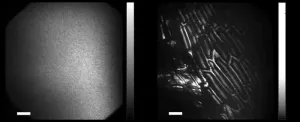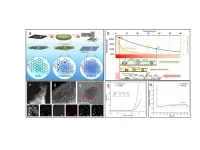(Press-News.org)
Key Takeaways
The world's first combined face and whole-eye transplantation used personalized surgical cutting guides and a novel “shortcut” to maintain blood flow to the transplanted eye.
Innovative surgical techniques ensured optimal blood flow to the retina, safeguarding the viability of the transplanted eye during the procedure.
An explanation of how an NYU Langone Health surgical team performed the world’s first combined face and whole-eye transplantation will be presented at the American College of Surgeons (ACS) Clinical Congress 2024 in San Francisco, California. Their achievement demonstrates the feasibility of transplanting an entire eye alongside a face transplant.
This operation, performed in 2023, showcases the potential for future eye transplant procedures and marks a significant advancement in vascularized composite allotransplantation (VCA). This type of transplantation is particularly challenging since, unlike organ transplants that involve just one type of tissue, like a kidney or heart, VCA involves transplanting a complex combination of different tissues — skin, muscle, blood vessels, nerves, and sometimes bone — all in one piece.
Led by Eduardo D. Rodriguez, MD, FACS, director of the face transplant program at NYU Langone Health, the surgery involved a multidisciplinary team of more than 140 medical professionals. The transplant was performed on Aaron James, a 46-year-old military veteran from Arkansas, who suffered extensive facial and eye injuries from a high-voltage electrical accident.
According to the researchers, the primary goal was to ensure the transplanted eye remained viable, and the innovative techniques used were critical to achieving that outcome. The team focused on optimizing blood flow, a key factor for the long-term success of such a complex transplant.
The team developed a microvascular bypass technique to maintain blood flow to the transplanted eye. This bypass used nearby blood vessels, specifically the superficial temporal artery and vein, which were rotated to connect to the transplanted eye’s ophthalmic artery and vein. This innovative approach minimized retinal ischemia (loss of blood flow) and simultaneously restored blood flow to the face and eye, addressing a major challenge in eye transplantation.
Key Surgical Achievements
Reduced Ischemia: The bypass technique shortened the time without blood flow, protecting the transplanted eye.
Enhanced Blood Flow: Post-surgery tests confirmed strong blood flow to the retina and other critical areas.
Surgical Precision: Customized cutting guides ensured precise alignment and preserved the intricate structures of the eye and surrounding tissue.
“The successful transplantation of a face and whole eye demonstrated that with the right surgical techniques, a whole-eye transplant is feasible and can maintain long-term viability,” said Bruce E. Gelb, MD, FACS, associate professor, department of surgery, at NYU Grossman School of Medicine. “Aaron James, the patient, was made aware that while sight restoration was not the goal, maintaining a healthy, vascularized eye represented a critical breakthrough that could significantly impact the feasibility of similar procedures in the future.”
Co-authors are Sachin Chinta, BS; Alay Shah, MD; David Tran, MD; and Daniel J. Ceradini, MD.
Authors have no disclosures to report.
Citation: Chinta S, et al. Revolutionizing Vascularized Composite Allotransplantation: Surgical Underpinnings of the World’s First Combined Face and Whole-Eye Transplantation, Scientific Forum, American College of Surgeons (ACS) Clinical Congress 2024.
# # #
About the American College of Surgeons
The American College of Surgeons (ACS) is a scientific and educational organization of surgeons that was founded in 1913 to raise the standards of surgical practice and improve the quality of care for all surgical patients. The ACS is dedicated to the ethical and competent practice of surgery. Its achievements have significantly influenced the course of scientific surgery in America and have established it as an important advocate for all surgical patients. The ACS has approximately 90,000 members and is the largest organization of surgeons in the world. “FACS” designates that a surgeon is a Fellow of the ACS.
Follow the ACS on social media: X | Instagram | YouTube | LinkedIn | Facebook
END
Key Takeaways
Two new studies shed light on the costs associated with newer weight loss drugs and their use before bariatric surgery.
Long term, the cost effectiveness of bariatric surgery is greater than that of GLP-1 RA weight loss drugs alone, but a combination of the two treatments is more cost effective than surgery alone.
Taking GLP-1 RA weight loss drugs in the year before bariatric surgery is not linked to worse health outcomes within one month after surgery, or significantly different weight loss one year after the operation.
Newer ...
Key Takeaways:
Microgravity Innovation: The unique conditions of low Earth orbit help to self-assemble human liver tissues with enhanced functionality, compared to Earth-based methods.
Advanced Tissue Preservation: The project includes developing a bioreactor for the stable supercooling preservation of tissues, a critical step toward transporting viable tissues back to Earth.
Clinical Implications: This research could lead to novel stem cell-derived liver tissues, providing ...
Key Takeaways
Implementing a system-wide preoperative nutrition program projected an 18% decrease in hospitalization days and a 33% decrease in postoperative complications across multiple surgical specialties.
The program’s financial implications include a projected annual savings of $7.8 million for the payer/insurance sector.
Preoperative nutrition interventions are shown to reduce "outlier days" — hospital days exceeding the expected number — which significantly contributes ...
Key Takeaways
Young adults with colon cancer are typically diagnosed at a later stage and with a more aggressive type of the disease. There are also racial and ethnic disparities, including a significantly higher rate of colon cancer among non-Hispanic Black adults.
Obesity, family history, inflammatory bowel disease, and symptoms, such as abdominal pain or rectal bleeding, are factors strongly associated with colon cancer in younger adults.
Important concerns for ...
Researchers at the University of California San Diego Center for Epigenomics (C4E) have developed a new technique, called Droplet Hi-C, that allows scientists to rapidly determine chromatin organization, the arrangement of genetic material within cells. Chromatin organization influences how genes are activated in our cells and, in turn, how those cells function. In addition to being faster than existing methods for studying chromatin organization, droplet Hi-C is more affordable, which could make it significantly easier for scientists to understand how genes influence the progression of complex diseases, such as cancer and neurological disorders.
The ...
All cancer mutations that cause drug resistance fall into one of four categories. New research has detailed each type, helping to uncover targets for drug development and identify potential effective second-line therapies.
In a new large-scale study, researchers from the Wellcome Sanger Institute, EMBL’s European Bioinformatics Institute (EMBL-EBI), Open Targets, and collaborators used CRISPR gene editing to map the genetic landscape of drug resistance in cancers, focusing on colon, lung, and Ewing ...
New study introduces a novel computational holography-based method that enables high-resolution, non-invasive imaging through highly scattering media, without the need for traditional tools like guide stars or spatial light modulators. By leveraging computational optimization, the method drastically reduces the number of measurements required and corrects over 190,000 scattered modes using just 25 holographic frames. This innovation shifts the imaging burden from physical hardware to flexible, scalable digital processing, allowing for faster, more efficient imaging across a wide range of fields, from medical diagnostics to autonomous navigation. Its importance lies in providing a versatile, ...
An international study involving people from 11 countries has shown most people, including those in areas most affected by climate change, don’t understand the term ‘Climate Justice’. However they do recognise the social, historical, and economic injustices that characterise the climate crisis. The findings could help shape more effective communications and advocacy.
Researchers from the Univeristy of Nottingham’s School of Psychology led a study that surveyed 5,627 adults in 11 countries (Australia, Brazil, Germany, India, Japan, Netherlands, Nigeria, Philippines, United Arab Emirates, United ...
The migration of the monarch butterfly is one of the wonders of the natural world. Each autumn, a new generation of monarch butterflies is born in the northern United States and southern Canada. Hundreds of millions of these butterflies then fly to the mountains of Central Mexico, between 4,000km and 4,800km away. There, they overwinter in forests of the sacred fir Abies religiosa at high altitudes. Without these sacred firs, the monarchs couldn’t survive their grueling migration.
But under global warming, these forests are predicted to slowly ...
Rapid synthesis of high-entropy alloy nanoparticles (HEA NPs) offers a new opportunity to develop functional materials in various applications. Although some methods have successfully produced HEA NPs, these methods generally require rigorous conditions such as high pressure, high temperature, restricted atmosphere and limited substrates, which impede practical viability.
In a new paper published in Light: Science & Applications, a team of scientists, led by Professor Zhu Liu from the Research Centre for Laser Extreme Manufacturing, Ningbo Institute of Materials Technology and Engineering, Chinese Academy of Sciences, have developed ...







